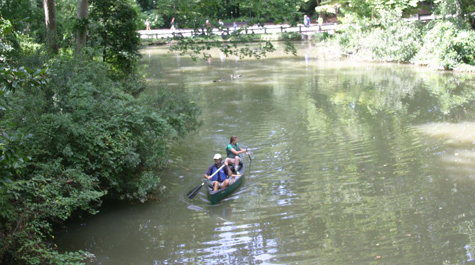Emergency siren makes it a bad day for turtle trapping
It was probably the worst day of the summer to trap turtles.
The weather was good and the season was right. The turtles have been out, too. People passing by Crim Dell usually can count on seeing four or five turtles near the surface of the pond and sunning themselves on fallen trees.
But Randy Chambers’ Wetland Ecosystems class just happened to pick Sept. 4 for their turtle trapping. It was the same day that William & Mary chose to test the university’s emergency warning and mass notification systems.
Chambers was setting up for trapping business shortly after noon. The turtles like to work the spillway area for handouts from students leaving the Sadler Center. At 12:14 p.m., the turtles were paddling around the spillway with their customary nonchalance, all eyes peeled for a tossed tidbit. At 12:15 p.m., the emergency siren blew—and all the turtles dove for the bottom.
Undiscouraged, Chambers and his class set about turtle trapping, anyway. Chambers, a professor in the Department of Biology and director of William & Mary’s W.M. Keck Environmental Field Lab, explains that the turtle collection at William & Mary is part of a larger initiative. The Ecological Research as Education Network, as it’s known, includes turtle censuses from 25 other schools in the United States.
The class used three methods to trap the Crim Dell turtles. They set out modified crab pots, essentially the same sort of baited wire cages used by Chesapeake watermen, but these have been fitted with a “snorkel” that sticks above the surface and lets the captured turtles breathe. Chambers uses these pots for his research on diamondback terrapin.
The second method involves hoop nets, a classic method used by commercial turtle trappers. The bait-seeking turtles enter one of a series of funnel-shaped nets and can’t find their way out. Chambers used a canoe to set the hoop nets in the upper reaches of Crim Dell, beyond the bridge.
The third method is the simplest. “The students toss bread in the water and wait there on the bank with a net for the turtles to come,” Chambers said.
The bread tossers attracted only bluegill and catfish, and the crab pots drew a blank as well. Only one turtle (and a couple largemouth bass) were caught by hoop nets.
“We’ve got one, anyway,” Chambers called as he brought the canoe alongside the spillway wall. He identified it as a yellow-bellied slider, one of six species of turtles known to live in the pond of William & Mary’s landmark.
The yellow-bellied slider was marked down as turtle number 13. Chambers identified the turtle’s gender by the shape of his tail and his elongated “ring finger” as an active male, “probably breeding with everything.”
He showed the class how Number 13 had growth rings on his scutes. Generally you can count on a year for each ring, but Chambers had to put a question mark next to “age” on Number 13’s data sheet.
He said that land-dwelling box turtles are usually right on the money when it comes to growth rings, but their aquatic cousins like Number 13 were denochronologically unreliable.
“You can count the rings on a box turtle until they get to 35 or 40 years old,” he said. “But aquatic turtles, because they’re in the mud and dragging around so much, their shells get really worn.”
Chambers filed three notches to mark Number 13, one in each of the marginal scutes of the carapace that biologists have designated for the numbers 8, 4 and 1, “which make 13, right?”
The members of the class laughed nervously at Number 13’s discomfiture as the turtle tossed his head and stretched his neck, trying to bite the hand that was filing him.
“We use markings like this for diamondback terrapins,” Chambers explained. “There’s a bald eagle nest near where we work and we sometimes find our notched terrapin shells under the eagle nest. Eagles like to eat diamondback terrapins.”
The filing finished, Chambers handed Number 13 to Maren Hunsberger ’15 for repatriation into Crim Dell. “Just heave him as far as you can,” Chambers told her.
“Really?”
“Noo-ooo!”
Hunsberger eased Number 13, notched but unharmed, gently back into the water.
 Skip to main content
Skip to main content



